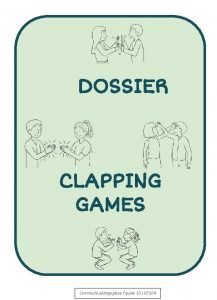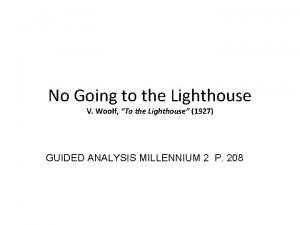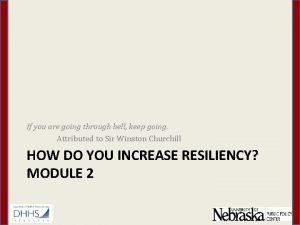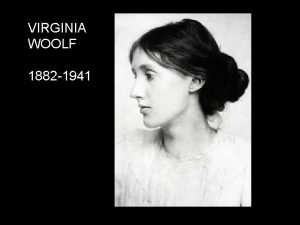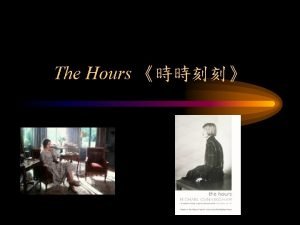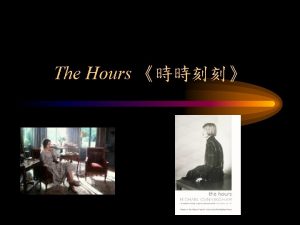No Going to the Lighthouse V Woolf To






- Slides: 6

No Going to the Lighthouse V. Woolf, “To the Lighthouse” (1927) GUIDED ANALYSIS MILLENNIUM 2 P. 208

Speaking 1. What does the title of the passage anticipate? Have you ever been to a Lighthouse? If you have, what emotions did you feel? • The title anticipates a trip to the lighthouse that for some reason will not take place. GUIDED ANALYSIS 1. Consider the plot. very little happens in the passage. While reading, highlight in the text what each character is doing. James Ramsay Mr Ramsay James Ramsay: he is “sitting on the floors cutting out pictures from an illustrated catalogue of the Army and Navy Stores (ll. 11 -12); Mrs Ramsay: she is “watching him guide his scissors neatly round ( the picture of) the refrigerator (ll. 20 -21) and knitting (l. 41); Mr Ramsay: he is “stopping in front of the drawing-room window (l. 23), grinning sarcastically (l. 29).

GUIDED ANALYSIS 2. Consider the dialogue a. Only three very short sentences are spoken by Mr and Mrs Ramsay. Highlight them in the text: Mrs Ramsay: “Yes, of course, if it’s fine tomorrow” (l. 1); “But you’ll have to be up with the lark” (ll 1 -2); “But, it may be fine – I expect it will be fine” (l. 40); Mr Ramsay: “but. . . It won’t be fine” (ll. 23 -24); b. Now say what different feelings they arouse. Mrs Ramsay agrees to their sailing to the Lighthouse the following day, if the weather is fine. This short agreement produces in James a feeling of happiness {(“extraordinary joy”, l. 3), “heavenly bliss” l. 13; “it was fringed with joy” , ll. 13 -14)} and expectation ( “the wonder to what he had looked forward. . seemed. . within touch”, ll. 4 -6). His father’s words instead arouse violent feelings of hatred and revenge in James’ heart. “Had there been an axe handy. . . James would have seized it” (ll. 25 -27); Mrs Ramsay dares not oppose her husband openly, but her tension is given by the words “making a little twist of the reddish-brown stocking she was knitting impatiently” (ll. 40 -41); Anyway, she goes on knitting the stocking for the little son of the lighthouse keeper, just in case. (By doing so, she also seems to want to show to her own son that there is some hope of going).

GUIDED ANALYSIS 3. Focus on the interior monologue. a. What future does Mrs Ramsay imagine for her son? • She imagines him “sitting” on the bench as a Judge, dressed in “ermine and red” or “directing. . . public affairs” (ll. 21 -22). b. What does James think of his father? • He hates his father because he likes “disillusioning his son” (l. 30), and “casting ridicule upon his wife” (l. 30). However, James recognises his father’s “accuracy of judgement” (l. . 32) and his incapacity of being untruthful (ll. 32 -33). c. What does James think of his mother? • He thinks “she is ten thousand times better than his father. (l. 31). d. What does Mrs Ramsay think of life? • He thinks that “his own children…. should be aware from childhood that life is difficult” (ll. 35 -36); and that the passage to adulthood requires “courage, truth, and the power to endure” (l. 39).

4. Personal response. a. Underline the simile used in the description of Mr Ramsay and say if you find it consistent with the idea you got of him. • The simile used is “lean as a knife, narrow as the blade of one” (ll. 28 -29); the description given is certainly consistent with the simile; Mr Ramsay is described as a hard, authoritative, severe man of sterling character and the image given reinforces this idea b. What idea do you get of Mrs Ramsay? . • She is a kind, highly sensitive woman, concerned about other people and anxious to make her son happy.

WRITING NES 5. Like Joyce, her contemporary, Virginia Woolf revolutionised the concept of plot, time and style. Comment on this statement giving reference to both novelists. (maximum 120 words). • James Joyce and Virginia Woolf revolutionized the realistic tradition of 19 th century fiction with the abolition of the narrator as mediator between the character and the reader. Mr Bloom, Molly, Mrs Dalloway and James Ramsay all take the reader inside their minds and what the reader follows are their thoughts or half-formed thoughts. Chronological time and fictional time have no direct relationship. Plots may be restricted to one day as in “Mrs Dalloway” and “Ulysses”, or to two days separated by a span of ten years , as in “To the Lighthouse”. The characters’ thoughts shift backward and forward in time, intermingling past, present and future in an apparently chaotic and fascinating flow of thoughts, free associations, memories and fantasies. (119 words)

